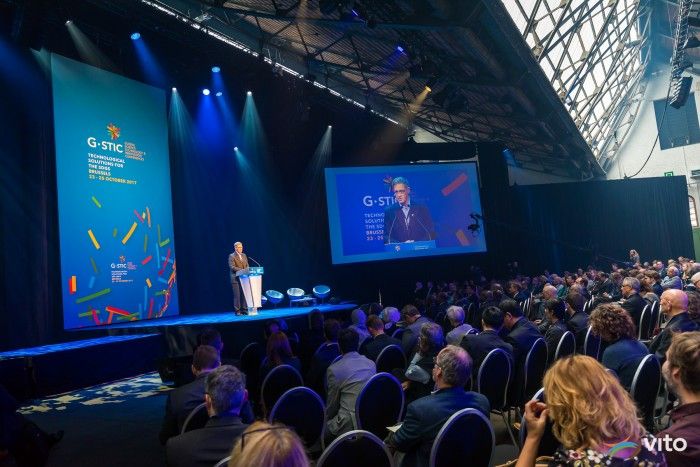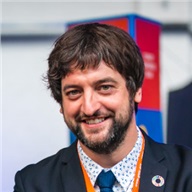Smart combination of technological solutions to accelerate realisation of SDGs.
- Scientists, entrepreneurs and policy makers from across the world gathered in Brussels for a three-day conference aimed at finding innovative technological solutions to realise the 17 sustainable development goals (SDGs).
- With this first edition of G-STIC (Global Science, Technology and Innovation Conference), research institute VITO sought to identify and promote the best market-ready and innovative technological solutions.
- “Business as usual won’t help us realise the SDGs by 2030 — what we need is a paradigm shift.”
- “The only way in which we can create a sufficiently effective approach to realise our SDG ambitions is by taking into account the limits of our planet and by utilising the opportunities provided by technological innovation and combination.”
In 2015, 193 countries joined forces under the banner of the United Nations to formulate 17 sustainable development goals. These so-called SDGs range from eradicating poverty and hunger to gender equality and quality education, via climate action, access to clean water and affordable, sustainable energy. “These goals are simply too ambitious to be achieved through business-as-usual. What we need is a genuine paradigm shift.” That, according to Dirk Fransaer, VITO’s Managing Director, was the aim of the first G-STIC event — a conference organised by VITO together with four other research institutes from Asia and Africa.
“It is a case of being smart when combining new and existing technologies and creating a framework in which innovation can flourish. Institutional barriers will need to be removed, and laws, regulations and habits will need to be changed. But the main thing we need is cross-sector cooperation to promote new business models and value chains and to demonstrate how combinations of integrated solutions and new business models can work in practice. This requires both commercial and political leadership.”
Luckily, many innovative technologies that are both ready to be implemented immediately and are affordable for large groups of people are already available. These sustainable technological innovations have come both from multinationals, as well as from local start-ups and communities. G-STIC brought people together from across various sectors and disciplines to jointly bring about a transition that benefits people, planet and profit.
Final conclusions: four opportunities for technological acceleration
On G-STIC’s closing day, the delegates set out their conclusions, which can be brought together in the form of four opportunities that will enable multiple SDGs to be tackled rapidly and in one go.
1. The SDGs will not be achieved by means of major technological innovations alone. These must go hand in hand with bottom-up solutions that are accessible and affordable for large groups of people, worked out by local communities and entrepreneurs themselves to tackle the concrete problems they are the first to face, and that affect them the most.
In the field of energy, for example, we must evolve from supply-driven, central solutions to demand-driven, decentralised solutions. The same applies to agriculture and food supply, where monocultures and industrial livestock farming must make way for an agroecology that is better aligned with local needs. In order to tackle world hunger, which still affects 815 million people – including 155 million children under the age of 5 – and obesity, which 650 million people already suffer from, investments and government subsidies for food production must be completely overhauled.
2. Our current economic model has produced unprecedented wealth and prosperity, but has now reached its absolute breaking point. We need new models and technologies that significantly reduce the demand for resources, generate significantly fewer emissions and produce significantly less waste. The evolution towards a circular economy with ‘Industry 4.0’ as a main facilitator will not only result in a more balanced use of resources, but will also create more jobs and prosperity. A circular economy will turn problems that cost money into solutions that are cost-neutral, or that may even generate profits.
Special sessions and workshops at G-STIC were devoted to several innovative solutions that serve as elements of this crucial evolution. As part of these sessions, scientists demonstrated solutions to use two of the biggest problems we currently face — waste water and CO2 — as raw materials. For example, CO2 can be converted into chemicals, fuel or building material. The main obstacle to overcome with regard to reusing/converting both waste water and CO2 is legal restrictions. Demands to ease these restrictions and give these emerging technologies the best possible chance to succeed were aired by various camps at G-STIC.
Delegates also focused on relatively ‘new’ raw materials, such as bamboo — a ubiquitous crop that thrives even in the most barren soil, where nothing else will grow. Bamboo is already being used as a component in wood and laminate, and is becoming an increasingly common sight in scaffolding or even bicycles.
3. ICT is a basic prerequisite to realise the SDGs and create opportunities that support sustainable lifestyles and production processes. Whether it’s smart cities, e-mobility, smart water management, smart agriculture or a circular economy: ICT forms the backbone of them all. Smartphones, mobile apps and social media have completely transformed our world, and the impact of blockchain technology, artificial intelligence, the internet of things, etc. is only growing.
Even today, 3.9 billion people remain digitally unconnected. Making the internet accessible to these people will create limitless opportunities to test and implement smart solutions through Living Labs and other forms of digital co-creation.
At G-STIC, special attention was paid to young people and women; two groups in which extra momentum is needed to guarantee internet access and technological education.
4. A large number of the technologies we need to achieve the SDGs are available today and market-ready, but business models, government policies and the institutional framework are holding them back. To effectively implement the available innovative technologies, we need a combination of political will, civil society engagement and entrepreneurial courage.
The final conclusions reached at the G-STIC conference will be passed to policy makers, Dirk Fransaer explains.“By building bridges between technological innovation and policy making, we hope this first edition of G-STIC can serve to accelerate the technological transition we need to realise the SDGs. Next year’s G-STIC conference will present an initial opportunity to take stock of our progress.”



